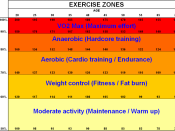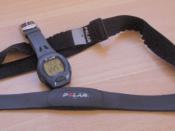Abstract
This scientific paper explores the human cardiovascular system as it relates to physical
fitness and heart rate.
Introduction
As an early part of our study of a science, we need to all be "on the same page" when it comes to a few terms. We can define science as a methodical approach to the acquisition of knowledge. This important word distinguishes how a scientist works from how other people learn about the world. Science is an approach that is methodical, and that approach helps acquire knowledge. Science is not the knowledge gained through the approach. Knowledge can be gained through a variety of ways, but science acquires knowledge methodically.
The method of science is a pathway that involves several steps. Scientists themselves might organize the pathway in slightly different ways, but scientists would agree that what is presented here is the scientific method.
The scientific method is based upon evidence rather than belief.
This distinguishes science from faith. A scientist is suitably skeptical of anything but good evidence. That is not to say that scientists lack faith...it is just that faith for them operates in a different sphere of their lives. In scientific work there is little room for faith; in life there is plenty of room for both.
Our hypothesis for this experiment was that a fit or "athletic" individual's pulse and blood pressure are lower and will return more quickly to the resting condition after exercise than in a less fit or "non-athletic" individual.
The heart beats about 60 to 80 times a minute when we're at rest. Resting heart rate usually rises with age, and it's generally lower in physically fit people. Resting heart rate is used to determine one's training target heart rate. Athletes sometimes measure their resting heart rate as one way to...



Cardiovascular Fitness
I don't understand why you included the first part of your essay. Not sure of the assignment, so can't be judgemental of what is and isn't included, but it seems like it is not important- and the way you worded your first sentence could be a lot better. "As an early part of our study of a science, we need to all be "on the same page" when it comes to a few terms." <It doesn't make much sense. I don't know why you included a bibliography. Maybe you needed to, but honestly, there wasn't anything to look up. What I would really mention though, is why an athletic, or physically fit, person has a lower resting heart rate than unfit person. An athletic person has a stronger heart, obviously because he exercises. Because of this, the athletic person's heart does not need to work as hard when it is at its "resting" heart rate zone. The best way to check your resting heart rate is right when you wake up before you get out of bed. So have a stop watch ready, and check your pulse. You only need to go up to 15 seconds, and then multiply those beats by 4. You can also check your target heart rate zone by using this simple formula:
220 -(your age) x .6 ; 220 -(your age) x .8
The experiment is the only "ok" part of this essay. The rest is scrap.
1 out of 1 people found this comment useful.